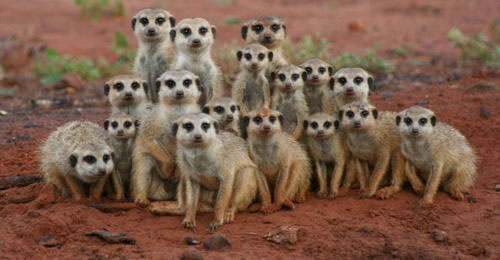Cooperative Breeding in Meerkats
Biology 342 Fall 08
Daniel Bernstein and Justine Spencer
Introduction
Meerkats (Suricata suricatta) are cooperatively breeding mongooses that are native to the Kalahari Desert in Southern Africa. A meerkat averages about one foot tall and weighs roughly two pounds at maturity. Their fur is tan with spots of brown on the back and black fur around the eyes and on the tail. They feed mainly on insects and small vertebrates, and spend much of their time foraging in the sand. At night they shelter in burrows, and at dawn they roam their territories, which may be several square miles. Meerkats typically live in groups of 3-50 individuals, and groups have an obvious hierarchical structure.
Image courtesy of raptor.co.za
Behavior
A defining characteristic of the meerkat is their cooperation within groups. On this site we will focus on one aspect of this cooperation: breeding. Pups are raised and nurtured by many helpers, as opposed to in many species where one set of parents raises their own young independently.
This site will explore this cooperative breeding behavior in terms of Nico Tinbergen's four ethological questions: Phylogeny, Ontogeny, Mechanism, and Adaptive Value. Phylogeny is the evolutionary history of a species. Ontogeny is the development of an organism during its lifetime. Mechanism is the question of how a behavior is carried out and by what physiological processes. Finally, adaptive value is the ultimate question of why a species does this behavior and as to what are the evolutionary advantages.
Key terms
Infanticide: the practice of killing an infant.
High skew: the ratio of mating partners is not 1:1. In meerkats, each female has more than one male to choose as a potential mate.
Subordinate: lower in rank. For meerkats, all females other than the dominant female are subordinates.
Reproductive potential: the maximum number of offspring a female can produce.
Allonursing: lactating female nurses another female's offspring.
